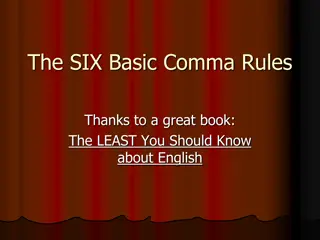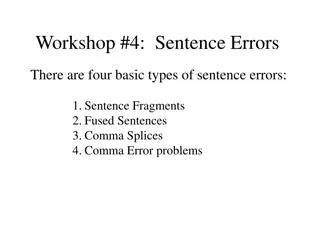Rules for Correct Comma Usage
Guidelines for using commas effectively, including their use in conventional situations like dates, addresses, and names, separating items in lists, and joining independent clauses with conjunctions. Proper comma placement is essential for clarity in writing and adhering to common punctuation rules.
Download Presentation

Please find below an Image/Link to download the presentation.
The content on the website is provided AS IS for your information and personal use only. It may not be sold, licensed, or shared on other websites without obtaining consent from the author.If you encounter any issues during the download, it is possible that the publisher has removed the file from their server.
You are allowed to download the files provided on this website for personal or commercial use, subject to the condition that they are used lawfully. All files are the property of their respective owners.
The content on the website is provided AS IS for your information and personal use only. It may not be sold, licensed, or shared on other websites without obtaining consent from the author.
E N D
Presentation Transcript
Comma rules Comma rule #1: Use a comma in a conventional situation (where a rule has become a rule, such as dialogue, the date, etc.) Comma rule #2: Use a comma to separate/join items in lists/IC s
COMMA RULE #1 Use a comma in conventional situations (a conventional situation is where comma use just becomes a rule; here are five common ones) ***Use a comma after these elements if the sentence continues Situation 1: Dates Ex. She was born January 19, 1999, in Doylestown, Pennsylvania, to two proud parents. Situation 2: Addresses Greeting and closing Situation 3: Certain parts of friendly letters ***For example: Martin Luther King, Jr., was a great man. Dr. Phil, P.H.D., is on television. Situation 4: In names that have a title Situation 5: Use in dialogue
COMMA RULE #2 Yes, you do place the comma here Use a comma to separate items in a series. Commas act as dividers for items in a series. You could connect them with the conjunctions and/or or you can, and should, use commas. But we consider that poor style. Ex. Fish and ice cream and burritos Or Fish, ice cream, and burritos A series is considered three or more words, phrases, or clauses. Otherwise you would just use and/or. Ex. Pens, pencils, and paper (words) In the morning, at lunch, and after dinner (phrases) I came, I saw, and I went home. (clauses) although an adjective list requires only two that occur side by side (w/o the use of a conjunction). Comma: Jeff ate a spicy,steamy bowl of chili. No comma:Jeff ate a spicy and steamy bowl of chili. *Be sure to also remember the forward-backward rule to determine if adjectives are equal. Equal: It was a damp, dreary day. Unequal: That is my favorite red sweater.
COMMA RULE #2 Use a comma with conjunctions when separating/joining two sentences instead of periods A compound sentence has not one but twoparts to the sentence. Those two parts are each sentences, or if you want to get fancy, those parts are called independent clauses. (Independent means it can stand alone.) Here are two simple sentences with one independent clause each: Alexis ate an enchilada. Artie gobbled up four tacos and an order of rice. Since they are two independent clauses, they MUST BE separated. We most often do this with a period. However, we have two other ways of doing so In a compound sentence, put a comma BEFORE the FANBOYS conjunctions. ***Remember, you only need a comma with and if you are separating two independent clauses. Don t forget the FANBOYS, or you may create a comma splice a BIG mistake. Or, if using a semicolon and an adverbial conjunction, we will place a comma after the HOTSHOT CAT. (IC;AC, IC)























